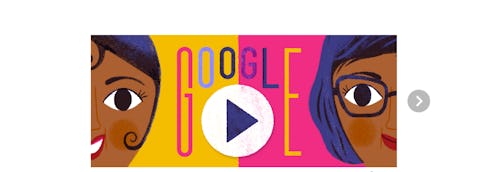News
The Google Doodle Celebrates Jazz Icon Josephine Baker

Google has rolled out a Google Doodle to celebrate Josephine Baker, the legendary jazz icon and civil rights activist who used her talents and fame to help combat racism. From poverty to international stardom, Baker overcame countless hurdles to become not only one of the first internationally known African American entertainers but also one of the most prolific artists of the twentieth century. On what would have been her 111th birthday, Google celebrated Baker's enduring legacy with a vibrant Google Doodle that's almost as multifaceted as the legend herself.
"Josephine Baker is probably best remembered for her dazzling performances, but she was so much more than just an incredible entertainer," Google Doodle designer Lydia Nichols tells Bustle. "From WWII spy to civil rights activist, Baker's talents and personality were only outsized by her accomplishments and ambition. She fought for equality and freedom through her art, her words, and her commitment to children. It's almost impossible to sum up such a multi-faceted figure."
Indeed, Baker did live a full life. Born in St. Louis, Missouri, as Freda Josephine McDonald on June 3, 1906, Baker helped support her family by doing domestic work for wealthy, white families as a young girl. In her early teens, Baker took up her father's vaudevillian trade and began singing and dancing in street performances. Eventually Baker moved to New York City and found success on Broadway in the musical Shuffle Along.
In the 1920s Baker moved to France, where her performance of Danse Sauvage in the show La Revue Nègre catapulted her to became one of the highest-paid performers in Europe. During World War II, Baker worked for both the Red Cross and the Free French Forces. However, she did her most daring work gathering intelligence and smuggling messages across borders for the French Resistance. For her services, she was awarded two of France's highest military honors – the Croix de Guerre and the Resistance Medal following the war.
But while Baker was a star beloved in France, racism and segregation back home in the United States meant Baker was not celebrated as the legendary jazz icon she had become overseas. And so Baker took it upon herself to help advance America's civil rights movement, working with the National Association for the Advancement of Colored People (NAACP) and refusing to perform in segregated or whites-only theaters. In 1963, she the only women to speak at the March on Washington. In a simple but powerful speech, Baker described the juxtaposition between her experiences being an African American performer in France and America.
Fueled by her belief in the possibility of equality and racial harmony, Baker adopted 12 children from around the world, referring to them as her "Rainbow Tribe." In 1975, at the age of 68, Baker died of a cerebral hemorrhage.
To highlight Baker's many accomplishments, Nichols designed a Doodle that takes advantage of an interactive slideshow format. Over the course of seven colorful slides, Nichols details Baker's childhood, her success as an artist, her work in the civil rights movement, and her transracial adoptive family. To make the Doodle pop with the same flair Baker possessed, Nichols turned to the Jazz Age for inspiration. "The bold limited palette and simple aesthetic were influenced by poster art of the 1920s and 30s when Baker broke onto the scene," she tells Bustle.
But Saturday's Google Doodle isn't just a celebration of what would have been Baker's 111th birthday. It's an homage to bold trailblazing women like Baker, who single handedly changed history. "It was truly an honor to research and create visuals for a woman of such brazen courage and passion," Nichols tells Bustle. "I hope today's Doodle will help viewers to learn more about her extensive and important legacy."